Violence & submission in the human past
The retreat of Gandhian ‘nonviolence’ in public affairs from its high points in the 1930s when the might of the British Raj in India was so seriously challenged by Gandhi and his followers, and since the 1950s and 1960s when Martin Luther King, Jr., led civil-rights demonstrators in facing police dogs and truncheons in the American South, is obvious today. That is scarcely surprising. It takes enormous self-discipline to invite attack and refrain from retaliation, and the moral effect of nonviolence depends on who witnesses such confrontations and how that larger public reacts. Violence exercised in secret against helpless victims, as at the Abu Ghraib prison in Iraq, escapes the price of public disapproval as long as it remains secret. And all too obviously, the art of shaping public opinion by managing the news has become a far more potent ally of established authority, even (or especially) in the exercise of violence, than it used to be.
Yet it is still true that violence has serious limits and that command of superior force is a very precarious basis for government. As Napoleon is supposed to have remarked, one can do anything with bayonets except sit on them. Effective and sustained public action requires at least tacit consent of the governed; active support is much more effective, if it can be contrived. More generally, human society depends on perpetual interaction between leaders and followers, and the exercise of violence and the threat of violence is part of that interaction. So is submission and obedience; and in practice the great majority of humankind has always submitted for very good reasons. Only so can collective action be efficiently exercised, only so can home territory be effectually defended, and, in a word, only so can conditions for group survival be optimized.
In all probability, violence and threats of violence played a prominent part in defining which of several competing males achieved leadership of the protohuman, and then the first fully human, bands of foragers from whom we all descend. Recent studies of “chimpanzee politics” by Franz de Waal and others offer a plausible model for what probably existed among our remote ancestors. Among chimps, careful observation showed that the alpha male maintains his position only by facing down repeated challenges from one or more of his subordinates–encounters usually limited to gestures of defiance before the challenger backs away without engaging in actual combat. But every so often, after years of backing down, a challenger does fight, and sooner or later one of them displaces the older alpha male, thus assuring a succession of physically vigorous leaders. Moreover, male chimpanzees guard their home territory against intruders from neighboring bands and, when unopposed, cross those borders to pick up extra food. As a result, band territories are elastic, widening or shrinking with population growth or collapse, and with the corresponding vigor of local defense and aggression. . . .
To read the full essay, access the PDF of the volume.
